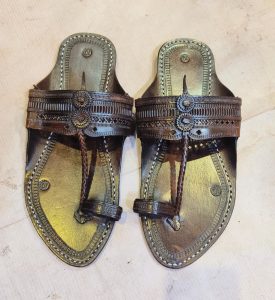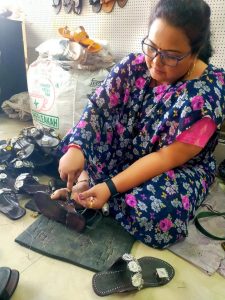Kolhapuri Chappals Walk the Prada Runway, Yet Local Artisans Get No Benefit From it
Kolhapur: Kolhapur, a city in western Maharashtra, known for wrestling, football, spicy non-vegetarian cuisine, and its iconic chappals, is in the spotlight for the past week, ever since international Italian luxury fashion brand 'Prada' showcased a design in its Spring Summer 2026 Milan Fashion Week, which appeared to be almost exactly like the handcrafted Kolhapuri chappal.
The Prada sandals are priced at about Rs 1.2 lakh, as per reports. The move has sparked criticism from people across Kolhapur, Maharashtra as well as the rest of India.
After Prada’s show at Milan, Kolhapur's local politicians and social media influencers jumped into the controversy, using the opportunity to start a campaign against Prada. Framing it as cultural theft, they have claimed that Prada copied the traditional craftsmanship of the Kolhapuri chappal.
But amid this entire controversy, a major and more critical question has emerged: What is the current status of the artisans behind the Kolhapuri chappals? What are the real challenges they face every day to sustain their business while a big luxury brand makes money off of identical designs?
It is equally important to also ask what steps the government or local administration has taken to support the artisans who create these traditional Kolhapuri chappals and to preserve the chappal industry, or to help promote theKolhapuri chappal on a global platform?
The makers behind Kolhapuri chappals
In Maharashtra, it is usually people from the Dalit and Charmakar (cobbler) communities who have traditionally made Kolhapuri chappals, and even today, it is largely these same communities who continue to make and repair them.
The original Kolhapuri chappal is made from animal leather, which gives off a strong smell. Due to this smell, people from other communities used to stay away from the process. Thus, it is only the Dalit-Charmakar communities that engaged in this work.
Authentic Kolhapuri chappals use high-quality leather that is naturally processed and it takes at least a week to make one pair of chappals. In some cases, it can also take over a month, depending on the chappal’s design. Traditional artisans craft the chappals entirely by hand. The detailed engraving and especially the fine design work is often done by women in the household.

Women creating the design work on Kolhapuri chappal. Photo Paytaan
Maruti, who sells chappals outside the Kolhapur bus stand, says, "I come from the Charmakar community. Earlier, my father used to make and sell chappals. The chappals he made were crafted entirely at my home and were sold for anywhere between Rs 40 to 200."
"Due to poverty, I couldn't pursue my education. No one else in my family was educated either. I couldn't carry forward my father's chappal-making business because we had no money. That's why today, I buy chappals from other makers and sell them," he adds.
Maruti is unaware that Prada featured a Kolhapuri-style sandal in its fashion show. He is completely unfamiliar with the controversy.
Like Maruti, many traditional chappal makers in Kolhapur still remain excluded from the mainstream education system. They lack adequate knowledge about digital platforms, online marketing, e-commerce websites and even government schemes like the GI tag. As a result, their traditional skills remain confined to the local Kolhapur market.
They are neither aware of branding strategies nor do they have experience in digital sales. As a result, most of them do not even receive fair prices for the chappal.
The essential raw material

Kolhapuri chappals. Photo: Manisha Doifode
In 2015, the Maharashtra government implemented a law banning the slaughterhouses. This decision automatically impacted the Kolhapur-based chappal-making business, as well as local Kolhapuri artisans. As a result of the ban, local tanneries in Kolhapur which used to process raw animal skin into durable, soft and chappal-friendly leather faced a complete halt in the supply of hides. Additionally, citing environmental regulations, the Maharashtra Pollution Control Board (MPCB) took action against several tanneries in Kolhapur and shut them down.
As a result, the leather required for the traditional Kolhapuri chappal industry now has to be imported from other states. Even today, local artisans and small-scale chappal manufacturers in Kolhapur import raw materials from Tamil Nadu and Karnataka. As the cost of chappal production has significantly increased, the market has been flooded with duplicate versions. This has severely affected traditional local artisans who make authentic Kolhapuri chappals. The local administration seems to have also failed to stop the sale of duplicate chappals.
Speaking to The Wire, Anurag from the brand Paytaan says, "I've been running the Kolhapuri chappal brand Paytaan for the past 11 years. The closure of tanneries in Kolhapur has hit the chappal business the hardest. Tanneries, which process raw leather before it can be used, were essential for every chappal maker. But the government shut down the tanneries along with the slaughterhouses.”
“Now, all the tanneries have shifted to the Karnataka border. The biggest irony is that we can't even source raw materials for Kolhapuri chappals within our own state Maharashtra. Everything has to be bought from other states. The state government or local politicians never seem to give this matter any serious thought,” he says.

Kolhapuri chappals. Photo: Manisha Doifode
Anurag further adds that the closure of tanneries and the resulting dependence on raw material from other states has made it difficult to make traditional Kolhapuri chappals. The quality of leather coming from outside states is inconsistent, leading to a rise in duplicate Kolhapuri chappals, which is impacting the original, traditional chappal makers.
When asked about Prada's chappal design showcased in the fashion show, Anurag says, “In this entire episode, someone in Kolhapur should have benefited, but who actually gained? Prada!
This was a great opportunity for Kolhapuri chappals to be appreciated.”
“The fact that Prada's chappal was priced at Rs 1.2 lakh could have been to sell your (Kolhapuri makers’) local product for even Rs 10,000. But instead, you started criticising Prada and made them issue a statement. What do you think will happen now? Will they ever again show interest in your craft? No,” he says, expressing frustration over the issue.
“The biggest fault lies with the social media influencers. They have no understanding of the ground reality. Most of them were the first to attack Prada and call it 'stolen design'. Then politicians jumped in and turned the whole thing into a political opportunity. Everyone used it for their benefit but those who were actually supposed to benefit from it, the traditional Kolhapuri chappal makers, got nothing out of it," he adds.
Duplicates dominate markets
The market for Kolhapuri chappals primarily depends on tourists visiting the city. Every day, thousands of tourists from within and outside Maharashtra visit the Mahalakshmi temple in the city. During their visit, they make it a point to stop by the chappal lane and purchase chappals. But these days, the duplicate chappals are dominating the market.
In 2019, the Kolhapuri chappal was awarded a Geographical Indication tag (GI Tag) by the Union government. However, currently, very few traditional makers have the GI certification.

Manisha Doifode, who runs Rohit Footwear in Dasara Chowk in the city and makes Kolhapuri chappals herself, received her official GI certification in 2023.
She says, "My husband and I received the GI tag for Kolhapuri chappals from the government in 2023. Receiving this tag was a form of official recognition for our craft. But there's still a question about how much actual benefit it brings. Today, there are a large number of duplicate chappals available in the market, and since they are cheaper, people prefer to buy them. This affects traditional artisans like us."
Manisha adds that today, the biggest challenge faced by traditional Kolhapuri chappal makers is the lack of capital. "We have looked at several government schemes, but in reality, they are of no real help. Even though there are loan schemes, the funds do not come on time. Many skilled artisans in Kolhapur fall behind despite having the right opportunities, simply because of the lack of funds."
Local traditional artisans in Kolhapur prefer to sell Kolhapuri chappals mainly in the local market. Some individuals have tried to take the brand beyond Kolhapur through the websites and other digital platforms. However, the original artisans who make these chappals mostly come from Dalit and marginalised communities, and due to a lack of education, limited financial resources and insufficient capital, they face many challenges.
Mahesh Gawali, who runs Das Footwear on Mahadwar Road in Kolhapur says, “We have been in this [Kolhapuri chappal] business since 1980. It started as a family tradition from my grandfather’s time. Prada has used the design of our chappal, so I believe they should have called it 'Kolhapuri chappal' because it is a copy of our original product.”
“Now, after this issue with Prada, some political leaders are stepping in, but not a single politician has ever visited us or inquired about our situation at Chappal Line in the past 10 to 15 years. Politicians only show up to take credit for an issue, but after that, no one thinks to ask about us,” he says.
What Prada has said
After these developments, The Wire reached out to Prada to get their side of the story. The luxury brand acknowledged that its sandals were “inspired” by traditional Indian footwear.
It stated, "At Prada Group, we have always celebrated craftsmanship, heritage and design traditions. Prada acknowledges that sandals inspired by traditional Indian footwear made in specific districts in Maharashtra and Karnataka, India, were featured in its Men’s 2026 Spring Summer show in Milan.
We are committed to responsible design practices, fostering cultural engagement and opening a dialogue for a meaningful exchange with local Indian artisan communities as we have done in the past in other collections to ensure the rightful recognition of their craft. We are in contact with the Maharashtra Chamber of Commerce, Industry & Agriculture on this topic."
This article went live on July first, two thousand twenty five, at three minutes past six in the evening.The Wire is now on WhatsApp. Follow our channel for sharp analysis and opinions on the latest developments.




